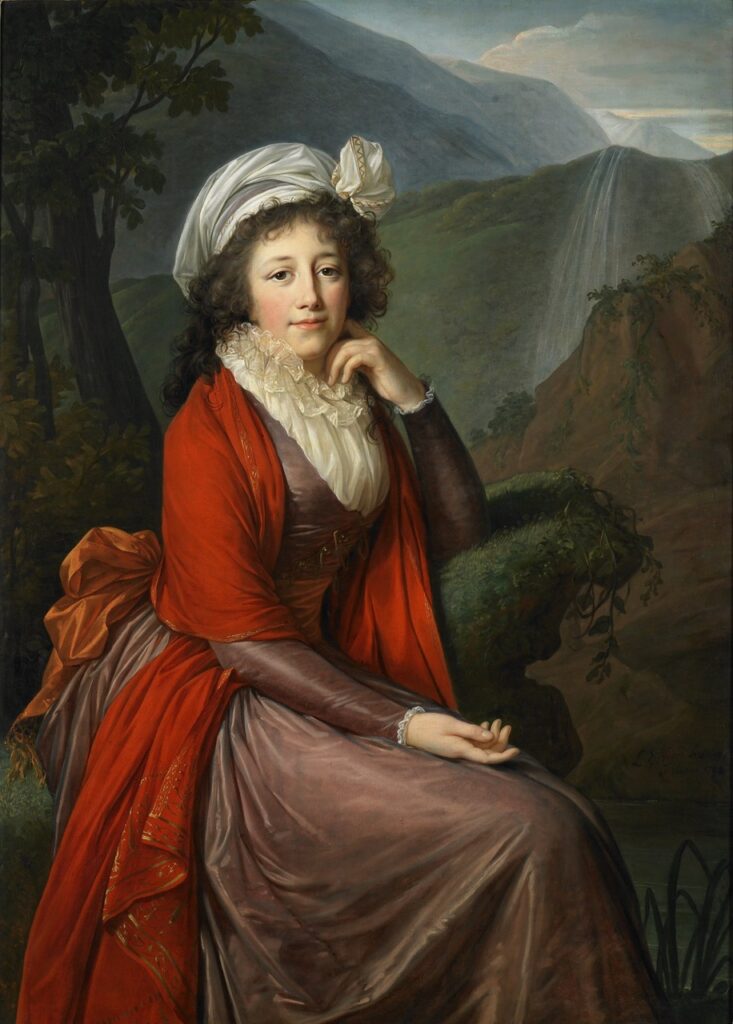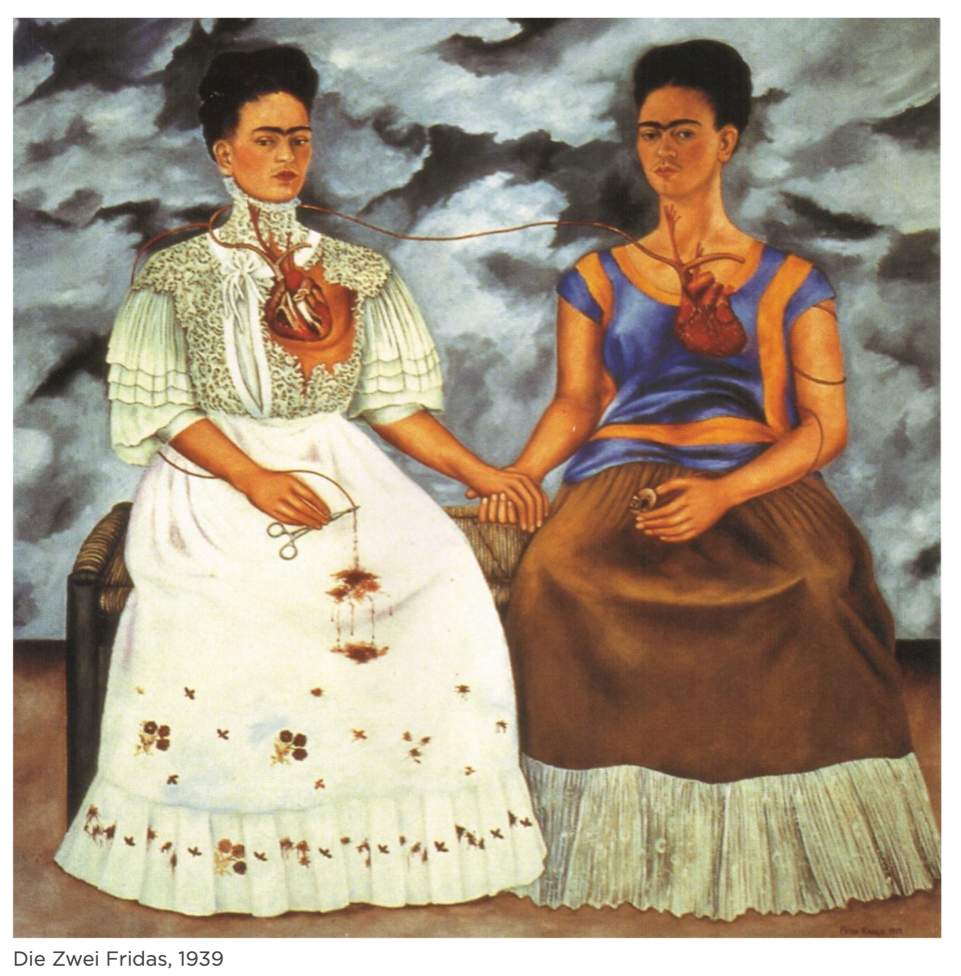Die Zwei Fridas, 1939
LOOK AT ME, RECOGNISE YOURSELF.
THIS WORLD OF OURS: PORTRAITS.
On LW, paper and foil. In the kunstGarten and the Street Gallery. Until 01.05.2022
Works by Monika Schönbacher-Frischenschlager, Kathrin Lorenz, Frida Kahlo, Louise-Élisabeth Vigée-Lebrun & and some Russian portraits without indication.
Curated by DP.in Irmi Horn

Monika Schönbacher-Frischenschlager SILVIA
Monika Schönbacher-Frischenschlager SILVIA
And again we orient ourselves towards the other. Looking for a moment of encounter, confrontation, connection. Throughout the ages we are touched by the expression in faces, in postures …
We encounter nakedness and attraction. Figuratively, but also only in the expression of facial expressions and gestures. We find defenselessness and domination, attraction and repulsion, dullness and liveliness … and everything has to do with our development, our physical and mental condition and often with the current taste of a society.
So each portrait offers a glimpse out of one’s own self: a stocktaking of the knowledge, natural condition and artistic understanding of the viewer could develop into a joyful memory, a re-encounter with one’s own history, a striking recognition and a mental departure, in addition to the passing encounter with a foreign face.
The artist Monika Schönbacher-Frischenschlager, born in Graz, studied to become a qualified teacher, as which she worked until 1991 and also passed on her knowledge and skills as a lecturer in Styrian teacher training in the field of art. From 1991 she devoted herself entirely to art. Her work has been shown in numerous exhibitions in Austria and abroad, and some of her works are on permanent display in public buildings.
The artist is a woman who observes nature in all its facets, in its beauty and cruelty. As a rational human being, she loves balanced justice and values the richness of diversity. In her work, she has been dealing for more than 30 years with issues related to the destruction of our habitats for economic interests and also critically illuminates social and societal dogmatic conditions of our culture. She thus directs the viewer’s gaze not only to phenomena that can be grasped visually, but also to her own perception, which she invites fellow human beings to question. She likes to paint large-format picture cycles in oil and create installations on her preferred subject matter. Two such installations, in which she takes a stand on the destruction of biodiversity and on the subject of finding the truth, can be seen in the kunstGarten Graz.On the subject of the environment, she has also designed books for children and adults to think about.
The Mexican Frida Kahlo is undoubtedly one of the best-known and most popular painters in the world. Her impressive paintings, her eventful life and her unusual lifestyle have made her an icon and cult figure throughout the world. After a serious bus accident, she was plagued by pain and had to undergo numerous operations in the course of her life. Her love for art, for her husband, the painter Diego Rivera, and for her country Mexico and its folk culture gave her the strength to go on living. Kahlo’s self-portraits are filled with symbolism that refers to her personal life. They often deal with her stormy relationship with Rivera and her broken body. Kahlo broke all the taboos of her time and became a cult figure. Her art and lifestyle inspire artists like Marina Abramović, fashion designers like Jean Paul Gaultier, Moschino and Dolce & Gabbana and musicians like Madonna and the band Coldplay.
Marie Louise Elisabeth VigĂ©e Le Brun “Portrait De La Comtesse Maria Theresia Bucquoi “,1793.
A small example:
The Two Fridas was her first large-scale oil painting. At that time, she normally painted small-scale works from her bed. One of the two Fridas, sitting on a bench holding hands and connected by a blood cannula, is wearing a European Victorian dress, the other a traditional Tehuana (Tehuantepec) costume. Frida Kahlo painted the picture shortly after her divorce from Diego Rivera. Â Rivera’s portrait in the hands of the right Frida and the missing piece of heart of the left Frida show her split. Her European connections were rejected by her strongly nationalistic husband. Â Frida, however, was shaped by her father’s European influence and her mother’s Mexican influence.
In her diaries, however, there is also an imaginary friend in her childhood. Does she sit on the bench with this one?
By using her body as a metaphor, she approaches the exploration of gender and gender roles: She depicts herself with facial hair, menstrual blood represents fertility. Frida represents her personal experiences as a woman in Mexican culture, making her a symbol of the feminist movement and her personal cultural identity.
The Mexican Frida Kahlo is undoubtedly one of the best-known and most popular painters in the world. Her impressive paintings, her eventful life and her unusual lifestyle made her an icon and cult figure throughout the world. After a serious bus accident, she was plagued by pain and had to undergo numerous operations in the course of her life. Her love for art, for her husband, the painter Diego Rivera, and for her country Mexico and its popular culture gave her the strength to go on living. Kahlo’s self-portraits are filled with symbolism that refers to her personal life. They often deal with her stormy relationship with Rivera and her broken body. Kahlo broke all the taboos of her time and became a cult figure. Her art and lifestyle inspire artists like Marina Abramović, fashion designers like Jean Paul Gaultier, Moschino and Dolce & Gabbana and musicians like Madonna and the band Coldplay.
Elisabeth-Louise Vigée-Lebrun (1755-1842), a portrait painter of the Rococo and Classicist periods who was appreciated throughout Europe. About 660 portraits and 200 landscape paintings by her have been preserved, 37 of which are self-portraits (20 copies in her own hand).
Education
Élisabeth-Louise VigĂ©e-Lebrun was the daughter of the only moderately successful Parisian painter Louis VigĂ©e (1715-1767) and the hairdresser Jeanne Maissin (1728-1800), so her father was her first teacher. After her father’s early death she was trained by Gabriel Briard and later Claude-Joseph Vernet.
Portraitist
Elisabeth-Louise Vigée-Lebrun quickly earned money with portrait commissions. The ladies of society in particular discovered Vigée, who was considered pretty and came from a poor background, and enjoyed having her paint them. On 11 January 1776 Elisabeth-Louise married the art dealer Lebrun, who continued to support her artistic activities.
The 24-year-old portraitist achieved her breakthrough when she was allowed to immortalise Queen Marie-Antoinette in 1778. The queen also pushed through the admission of her favourite painter to the Academy (against the resistance of her male colleagues and with the help of the voice of King Louis XVI). She became a member of the Academy on 31 May 1783, together with AdĂ©laide Labille-Guiard. The Queen’s favour brought Elisabeth-Louise VigĂ©e-Lebrun a large number of commissions, but the painter’s close relationship with her high-ranking model was the reason for her leaving Paris in 1789.
Emigration and return to Paris
First she emigrated to Italy with her daughter, where she painted portraits in Rome, then she travelled on to Naples, Vienna, Berlin and St. Petersburg, where she painted portraits of members of the high nobility. A self-portrait by VigĂ©e-Lebrun from 1790, now kept in the Uffizi, was a gift to the Grand Duke of Tuscany, Marie-Antoinette’s brother and later Emperor Leopold II of Austria. This is why the painter is currently working on a portrait of Marie-Antoinette at the easel. Presumably the artist also wanted to identify herself as a loyal royalist. Elisabeth VigĂ©e-Lebrun is dressed in a costume reminiscent of the fashion of the first half of the 17th century, with which the painter expressed her admiration for Anthonis van Dyck. The self-portrait, which appears spontaneous due to the rotation, entered the Galleria dei autoritratto [Gallery of Self-Portraits], which was already famous at the time.
On 18 January 1802 she was able to return to Paris, where she lived in a country house in the surrounding area. Around 1810 she painted Madame de StaĂ«l, whom she had met on a trip to Switzerland. The women’s rights activist and poet is depicted in the guise of Corinna, the heroine of her novel of the same name.

Marie Louise Elisabeth VigĂ©e Le Brun “Portrait De La Comtesse Maria Theresia Bucquoi “,1793
Vigée-Lebrun in Vienna
At the beginning of 1793 Elisabeth VigĂ©e-Lebrun came to Vienna, where she stayed until April 1795. She also created important portraits in the Habsburg residence city – above all for the princely Liechtenstein family. For example, she painted “Karoline Princess of Liechtenstein, nĂ©e Countess of Manderscheidt, as Iris” (wife of Prince Alois I) and her sister-in-law Hermenegilde in the role of Ariadne. Both portraits hung in the family’s neoclassical Majoratshaus in Herrengasse (demolished). Since there is no evidence of any other role portraits in VigĂ©e-Lebrun’s oeuvre, she probably took her cue from Angelika Kauffmann’s portraits for this – as well as for the freer style of painting and the ideal of naturalness. The painter also made fruitful use of her knowledge of the “attitudes” of Lady Hamilton in Naples and the depictions of dancers in frescoes in Herculaneum. How unconventional the depiction must have seemed to contemporaries is revealed by the fact that the prince’s grandparents expressed their surprise. VigĂ©e-Lebrun wrote about this in her “Souvenirs”:
“I brought the large portrait of the Princess Liechtenstein that I was doing at the time to Hietzing to finish it. This young princess was very good-looking: her pretty face had a lovely and heavenly expression which gave me the idea of depicting her as an iris. She is painted in full figure, and floating in the air, her veil, in the colours of the rainbow, surrounds her and floats around her. It must be added that I painted her with bare feet; but when the picture was placed in the Prince’s gallery, the heads of the family were very shocked to see that the Princess was shown without shoes. The Prince told me that he had a pretty pair of ball shoes put on under the portrait, which – he said to the grandparents – were about to slip off and fall on the floor.”
INFORMATION
- Please make reservations not later than 2 hours before the programme begins: kunstGarten@mur.at or +43 316 262787.LOOK

